LEON THEREMIN
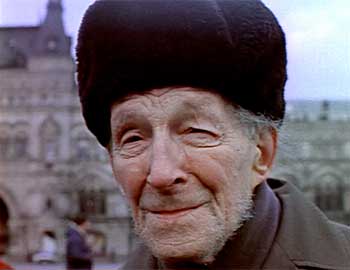 (russian: Lev Sergeyevich Termen) was born in 1896 in Petrograd (today St. Petersburg). He studied physical mathematics at St. Petersburg University and violoncello at the Conservatory. In search of instrument, which could be more intuitively played as the violoncello, in 1919 he invented the Theremin (russ. Termenvox), one of the world’s first electronic instruments. The invention was even presented to Lenin, who was impressed by it, but rather paid attention to the strategic utilisation of the instrument- as a motion detector. In the late 1920ies Theremin went touring around cities across Europe and the USA to present his invention that gained a lot of attention from critics and audiences. ‘A Theremin in every home’ was the vision of the RCA, which decided to mass-produce the instrument in the US.
(russian: Lev Sergeyevich Termen) was born in 1896 in Petrograd (today St. Petersburg). He studied physical mathematics at St. Petersburg University and violoncello at the Conservatory. In search of instrument, which could be more intuitively played as the violoncello, in 1919 he invented the Theremin (russ. Termenvox), one of the world’s first electronic instruments. The invention was even presented to Lenin, who was impressed by it, but rather paid attention to the strategic utilisation of the instrument- as a motion detector. In the late 1920ies Theremin went touring around cities across Europe and the USA to present his invention that gained a lot of attention from critics and audiences. ‘A Theremin in every home’ was the vision of the RCA, which decided to mass-produce the instrument in the US.
In 1938 Theremin was allegedly forced to return to the USSR, where he was accused of anti-Soviet propaganda and sent to a secret laboratory in the Gulag camp to research and work for the regime.
Besides the well-known instrument, Theremin made numerous groundbreaking inventions. In 1926 he devised the interlace technology for improving the quality of video signals, which is still widely used in video and TV technology. He also created devices for eavesdropping, the Buran, a prosecutor of the modern laser microphone and a device called ‘The Thing’, which monitored the US embassy in Moscow for seven years, until it was accidentally discovered. It was a passive audio transmitter, a early form of an RFID transmitter.
→ About Leon Theremin on Wikipedia
→ Interview with Leon Theremin by Olivia Mattis
ANDREY SMIRNOV
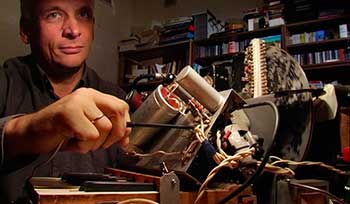 Andrey Smirnov (1956) is an interdisciplinary artist, independent curator, collector, writer, composer, researcher and developer of new techniques in computer music. He is a Senior Lecturer and a Head of the Sector for Multimedia at the Center for Electroacoustic Music at Moscow State Conservatory and a Professor at the Rodchenko School for Photography and Multimedia where he teaches courses on history and aesthetics of electro-acoustic music, sound design and composition, new musical interfaces and physical computing. In 1992-2012 he was the founding director of the Theremin Center in Moscow. He has conducted numerous workshops and master classes in the U.S., Europe and Russia, and participated in various festivals and conferences. Since 1976 he conducts research on the development of electronic music techniques and gestural interfaces. His collection of the historical documents and original electronic musical instruments has been combined with extensive research into the history of music technology with broad experience in composition, interactive performance and curatorial activities.
Andrey Smirnov (1956) is an interdisciplinary artist, independent curator, collector, writer, composer, researcher and developer of new techniques in computer music. He is a Senior Lecturer and a Head of the Sector for Multimedia at the Center for Electroacoustic Music at Moscow State Conservatory and a Professor at the Rodchenko School for Photography and Multimedia where he teaches courses on history and aesthetics of electro-acoustic music, sound design and composition, new musical interfaces and physical computing. In 1992-2012 he was the founding director of the Theremin Center in Moscow. He has conducted numerous workshops and master classes in the U.S., Europe and Russia, and participated in various festivals and conferences. Since 1976 he conducts research on the development of electronic music techniques and gestural interfaces. His collection of the historical documents and original electronic musical instruments has been combined with extensive research into the history of music technology with broad experience in composition, interactive performance and curatorial activities.
→ For more info go to Andrey Smirnov’s Site
STANISLAV KREICHI
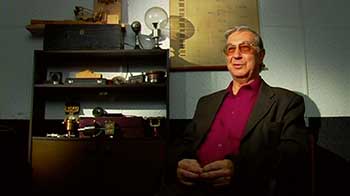 Stanislav Kreichi was born 1936 in Kutaisy, Georgia. Sound engineer, composer. Lives and works in Moscow, State University. For more than 50 years he has been working with the ANS synthesizer - a photoelectronic instrument which takes its name from the initials of Russian composer Alexander Nikolayevich Scriabin. The ANS synthesizer has been invented in 1938 and designed by Eugene Murzin in 1958, together with a group of engineers and composers. Stanislav Kreichi joined this group in 1961 and with the ANS composed music for several films, performances and shows, e. g. "Into Space" by Andrew Sokolov, "Echo of the Orient". Records in 1997 on MELODY: "ANS". The ANS synthesizer remains a unique apparatus available to only a limited circle of musicians: the single experimental model of the device in existence belonged for a long time to Moscow State University, where a general lack of space and technical support have prevented a widening of the circle of ANS users. Now it stands in the Glinka Museum in Moscow. Although the ANS has not achieved widespread fame, the idea of directly transforming graphic structures into sound structures has not lost it’s relevance and can now be used successfully in computer music.
Stanislav Kreichi was born 1936 in Kutaisy, Georgia. Sound engineer, composer. Lives and works in Moscow, State University. For more than 50 years he has been working with the ANS synthesizer - a photoelectronic instrument which takes its name from the initials of Russian composer Alexander Nikolayevich Scriabin. The ANS synthesizer has been invented in 1938 and designed by Eugene Murzin in 1958, together with a group of engineers and composers. Stanislav Kreichi joined this group in 1961 and with the ANS composed music for several films, performances and shows, e. g. "Into Space" by Andrew Sokolov, "Echo of the Orient". Records in 1997 on MELODY: "ANS". The ANS synthesizer remains a unique apparatus available to only a limited circle of musicians: the single experimental model of the device in existence belonged for a long time to Moscow State University, where a general lack of space and technical support have prevented a widening of the circle of ANS users. Now it stands in the Glinka Museum in Moscow. Although the ANS has not achieved widespread fame, the idea of directly transforming graphic structures into sound structures has not lost it’s relevance and can now be used successfully in computer music.
source: http://www.theremin.ru/people/kreichi/
→ ANS synthesizer on wiki
ALEXEI BORISOV
Making music on the fringe since the underground movement ignited in Russia in the beginning 1980s, Alexei Borisov has developed an impressively diverse body of work as a member of NIGHT PROSPEKT, F.R.U.I.T.S. and VOLGA, among many other projects.
Born in Moscow on December 7, 1960, Alexei Borisov graduated the Moscow State University where he had studied History and Arts. His controversial performing career (as a guitarist) began in the CENTER new-wave group, in 1980. Next year, he formed the PROSPEKT mod-band. And re-loaded it in 1985 as the shifting NIGHT PROSPEKT with then-partner Ivan Sokolovsky. After the actual dissolution of the band in the beginning 1990s, he surfaced then in the "noise reconstruction and techno acoustics" duo F.R.U.I.T.S. with Pavel Zhagun (also known as PIEZO) and in various other art/noise/industrial acts.
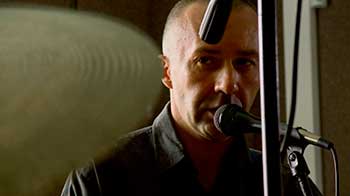 Being left with little possibility of finding a label to fund and promote his most radical projects, Alexei Borisov with his old-associate, an experimental Finnish sound-sculptor Anton Nikkila established in 2000 their own N&B Research Digest label.
Being left with little possibility of finding a label to fund and promote his most radical projects, Alexei Borisov with his old-associate, an experimental Finnish sound-sculptor Anton Nikkila established in 2000 their own N&B Research Digest label.
Among other Borisovs' collaborations are the joint projects with the performance-group "North" (Russia), KK Null (Japan), Jeffrey Surak (USA), Leif Ellgren (Sweden). Borisov also collaborates with the video-artist Roman Anikushin, multimedia-artists Aristarh Chernishev and Vladislav Efimov and also with Olga Subbotina, Moscow theatre director. Since 2009 Borisov performs mainly with drummer Olga Nosova as duo Astma.
Outside of his native Russia, Alexei Borisov is probably best known as a live performer with a sound and visual style that make his performances transcend the usual gig situation and resemble Beckett-style absurd theatre. Perhaps the most appropriate term for their soundtrack would be ”live collage”, often based on domestic or everyday material - ”found sounds” and home recordings of all sorts. They include field recordings of arbitrary soundscapes and conversations, mostly done diary-style with a cheap dictaphone, Borisov reciting his automatic writing-type lyrics, snippets of music from the radio, separate instrument tracks recorded for his other projects, solo playing on various instruments in a sleepwalking style or ”blindfolded”, as he has described his working (anti-)method with computers. The elements are mixed and cut up through effects in a manner which remotely resembles dj'ing with its sharp timing - Borisov's long experience as a live dj can be felt - or a manual telephone operator turning his work at a switchboard into poetry, as David Keenan noted in The Wire magazine about his live album Before the Evroremont: ”The whole is rent with fuzzy, intercepted conversations that sound like archived wiretaps”. (by Anton Nikkila)
more info:
→ Alexei Borisov: OF FIRST RUSSIAN ELECTRONIC MUSIC, PEOPLE AND INSTRUMENTS
http://shum.info/borisov
http://www.nbresearchdigest.com/borisov/
RICHARDAS NORVILA
Art projects in music, cinema, theatre and perfumery. Soundtrack writing. Psychotherapy practice. Professional identity - Alchemist.
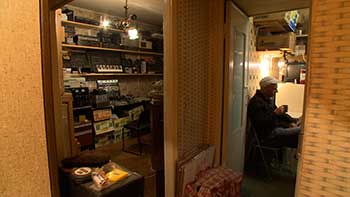 Composer, Musician and Performer Richardas Norvila was born in 1961 in Lithuania. He studied Philosophy and Medical Psychology at the Moscow State University and the C.G. Jung Institute in Zurich, Switzerland. In 1993 he received a doctors degree in Philosophy. Since 1998 he lives as a freelance composer and psychotherapist in Moscow.
Composer, Musician and Performer Richardas Norvila was born in 1961 in Lithuania. He studied Philosophy and Medical Psychology at the Moscow State University and the C.G. Jung Institute in Zurich, Switzerland. In 1993 he received a doctors degree in Philosophy. Since 1998 he lives as a freelance composer and psychotherapist in Moscow.
After returning from Switzerland, Norvila began to experiment with the sounds of Soviet made synthesizers, drum machines and effects and created a style, which he himself calls ‘Benzo House’. The word ‘Benzo’ derives from benzene (patrol), an essential component of Moscow’s air, which becomes part of the people’s metabolism. His collection of soviet analogue machines grew with the years and fills up his small studio in the outskirts of Moscow. In cooperation with technician Rafael Gafarov, Richardas developed a kind of ‘therapy’ for the mostly broken or poorly working instruments to give them a second life.
In his album ‘The Tapes’ he tells stories about the Soviet and post-Soviet everyday life: A seasonal worker from the province, who cannot find his flat in the concrete jungle of Moscow and gets lost. A factory worker, who for the first time in his life sees the endless nature of the Kazakh steppe.
More Info http://www.letov.ru/norvila
DMITRY MOROZOV
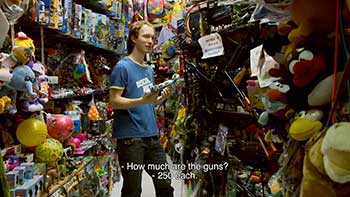 Moscow media-artist, musician and engineer of strange-sounding mechanisms Dmitry Morozov created his project ::vtol::. Starting in mid 00s, Dmitry actively began using DIY and circuit-bent instruments for his own music projects, as well as making instruments for other musicians and media artists at the same time. He is the first serial music and video synthesizer producer in all of post-soviet territories, after the collapse of USSR.
Moscow media-artist, musician and engineer of strange-sounding mechanisms Dmitry Morozov created his project ::vtol::. Starting in mid 00s, Dmitry actively began using DIY and circuit-bent instruments for his own music projects, as well as making instruments for other musicians and media artists at the same time. He is the first serial music and video synthesizer producer in all of post-soviet territories, after the collapse of USSR.
Besides making music and instruments, Dmitry creates audiovisual art-installations and advocates circuit bending and DIY electronic in Russia by means of lectures and workshops. As artist and musician he has participated in many art festivals and gigs in Russia, France, Belgium, Switzerland, Turkey, USA, Serbia, Slovenia, China, Hong Kong, India, Lithuania and Israel.
Resident of soundartist.ru and Nikola-Lenivets
Visit Dmitry Morozov's site http://vtol.cc
ALEXEI ILYINYKH
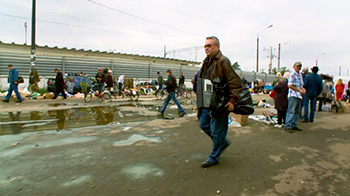 Dealer of Soviet Analogue Equipment, Electrician, Musician.
Dealer of Soviet Analogue Equipment, Electrician, Musician.
Born in the village of Vereshagino, Perm region, Alexei attended the Perm Railway Institute, specializing in Contact System Electrics. At that time he started to play in a band at a local restaurant. Together with his friend Valerij he then started to trade with electronic musical instruments, which was considered illegal speculation in Soviet times. Valerij was sentenced to jail for five years, Alexei managed to run off. Since then, Alexei lives in Moscow, continuing his business, but already legally.
